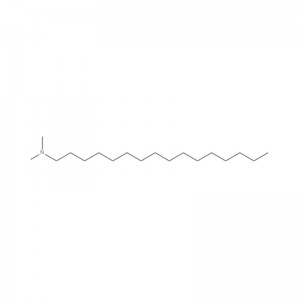
Products
Factory wholesale Biotechnology And Pharmaceutical - China N,N-dimethylhexadecylamine Manufacture Supplier – Longo Detail:
Structural Formula

Physical Properties
Appearance: colorless to light yellow liquid
Density: 0.801 g/mL at 20 °C (lit.)
Melting point: 12 °C
Boiling point: 148 °C / 2mmHg
Refractivity: n20/D 1.444
Flash point: 147 °C
Safety Data
Belongs to the dangerous goods
Customs code:2921199090
Export Tax Refund Rate(%):13%
Application
Is an industrial bactericide. Used for preparing quaternary ammonium salt, betaine, tertiary amine oxide, etc. Raw materials for producing high-efficiency whitening agents, pesticide emulsifiers, plant growth stimulator A-naphthylacetic acid, surfactants, solvents, etc.; Printing and dyeing carrier and heat carrier of PVC fiber and polyester; Determination of octane number and cetane number of diesel oil.
Hexadecyl dimethyl tertiary amine is an industrial fungicide. Industrial fungicides are preparations used in industry to kill or inhibit the growth of microorganisms, with numerous applications. Quaternary ammonium biocides are one of the most widely used industrial biocides, but Chemicalbook is currently widely used quaternary ammonium biocides are generally small molecular weight, with a certain degree of physiological toxicity and skin irritation, in the process of use will migrate and leach and released into the surrounding environment, which may cause damage to organisms and the environment.
Emergency response to a spill
Precautions for personnel, protective equipment and emergency procedures
Use personal protective equipment. Prevent inhalation of vapors, aerosols or gases. Ensure adequate ventilation. Evacuate personnel to a safe area.
Environmental Protection Measures
Do not allow product to enter sewers.
Methods and materials to contain and remove spills
Absorb with inert adsorbent material and dispose of as hazardous waste. Store in appropriate closed containers for disposal.
Handling Disposal and Storage
Precautions for safe handling
Prevent inhalation of vapors and fumes.
General fire protection measures.
Conditions for safe storage, including any incompatibilities
Store in a cool place. Keep containers tightly closed and store in a dry, ventilated area.
Opened containers must be carefully resealed and kept in an upright position to prevent leakage.
Inflatable storage is sensitive to carbon dioxide.
Product detail pictures:
Related Product Guide:
It really is a good way to further improve our goods and service. Our mission would be to acquire inventive items to buyers with a very good encounter for Factory wholesale Biotechnology And Pharmaceutical - China N,N-dimethylhexadecylamine Manufacture Supplier – Longo , The product will supply to all over the world, such as: Armenia, Thailand, Czech, Thus far, our item associated with printer dtg a4 may be shown in foreign nations as well as urban centers, which are sought after simply by targeted traffic. We all highly imagine that now we have the full capacity to present you with contented merchandise. Desire to collect requests of your stuff and produce the long-term co-operation partnership. We very seriously promise:Csame high quality, better price; exact same selling price, higher quality.
This company has a lot of ready-made options to choose and also could custom new program according to our demand, which is very nice to meet our needs.





